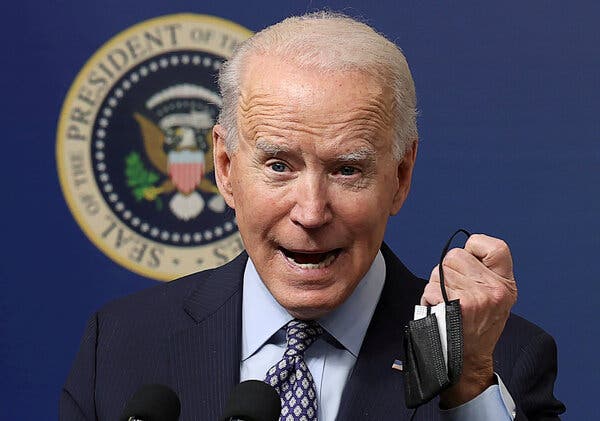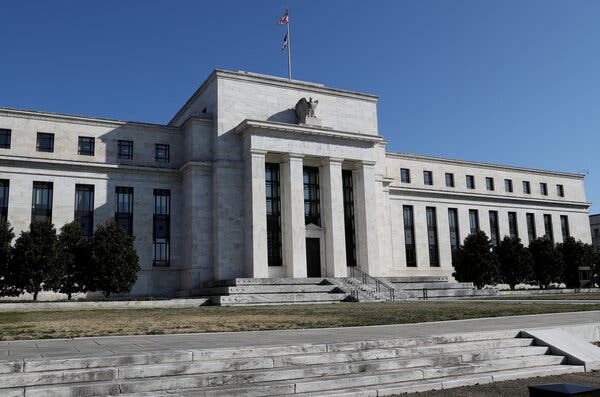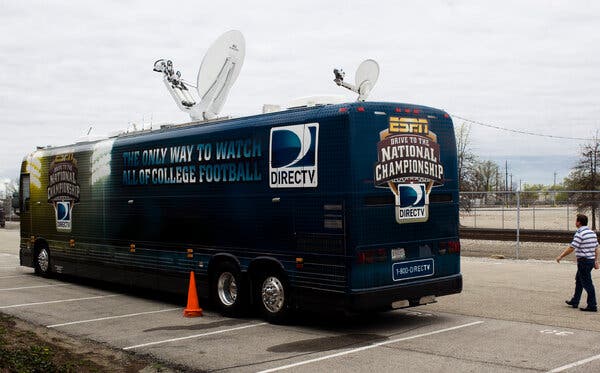Personal income was up a remarkable 10 percent in January, the Commerce Department reported on Friday, but the increase was almost entirely attributable to the $600 government relief checks and unemployment insurance payments.
Spending last month also increased by a healthy 2.4 percent, largely because of purchases of goods, while purchases of services lagged as the pandemic continued to weigh on the leisure and hospitality industries.
It was the biggest jump in personal income since April, when the figure was lifted by nearly $3 trillion in government transfer payments. That was mostly in the form of $1,200 checks that millions of households received from the federal government.
The combination of government aid and reduced spending because of the pandemic led to a big buildup in savings last year, said Jay Bryson, chief economist for Wells Fargo. He estimates that U.S. households were sitting on $1.5 trillion in extra savings even before the latest round of stimulus payments.
“People were getting all this money and they had no place to spend it because the economy was shut down,” he said. “So what did they do? They literally put it in the bank.”
That cash stockpile will grow even larger if Congress passes another round of aid, as now seems likely. But as the pandemic ebbs, Americans are likely to start spending again — turning the built-up savings into fuel for the economy.
“We just think there’s going to be this huge pent-up demand for services that’s going to be funded by that excess savings,” Mr. Bryson said.
But not all the government aid is being saved. Retail sales surged in January, a sign that some Americans were spending the money. Some of that spending might have been on essentials, as unemployed workers refilled pantries after weeks with little help. But some of it might also reflect the gradual reopening of the American economy, even as the pandemic continues to rage.
“We’ve learned to deal with this thing in the last year,” Mr. Bryson said.

President Biden has compared the fight against the coronavirus to wartime mobilization, but with the exception of pharmaceutical companies, the private sector has done relatively little in the effort. It has not made a major push to persuade Americans to remain socially distant, wear masks or get vaccinated as soon as possible.
Biden administration officials and business leaders will announce a plan on Friday to change that, David Leonhardt of The New York Times reports in The Morning newsletter.
The plan includes some of the country’s largest corporate lobbying groups — like the Chamber of Commerce, the Business Roundtable, the National Association of Manufacturers and groups representing Asian, Black and Latino executives — as well as some big-name companies.
Ford and Gap Inc. will donate more than 100 million masks for free distribution. Pro sports leagues will set aside more than 100 stadiums and arenas to be used as mass vaccination sites. Uber, PayPal and Walgreens will provide free rides for people to get to vaccination sites. Best Buy, Dollar General and Target will give their workers paid time off to get a shot. And the White House will urge many more companies to do likewise.
Many of the steps are fairly straightforward. That they have not happened already is a reflection of the Trump administration’s disorganized pandemic response. Trump officials oversaw a highly successful program to develop vaccines, but otherwise often failed to take basic measures that other countries did take.
“We’ve been overwhelmed with outreach from companies saying, ‘We want to help, we want to help, we want to help,’” said Andy Slavitt, a White House pandemic adviser. “What a missed opportunity the first year of this virus was.”
Stocks on Wall Street rose in early trading on Friday, trying to find a footing after Thursday’s steep decline as a sell-off in the bond market eased up.
Bond prices rose and the yield on 10-year Treasury notes dropped slightly to 1.47 percent. On Thursday, the yield on those government bonds rose above 1.6 percent, setting off a slide in U.S. stocks that rippled across the globe.
The S&P 500 had fallen close to 2.5 percent on Thursday, and stock indexes throughout Asia followed suit. The performance in Asia was its worst since March, by one measure, though it followed months of significant gains as investors bet on the prospect of global economic recovery from the coronavirus outbreak.
Major European markets were also lower on Friday, though they had recovered some of their sharpest losses by the afternoon. The Stoxx Europe 600 was down 1 percent, but had earlier fallen as much as 1.7 percent.
Investors have recently been rattled by the sharp rise in bond yields. This month, 10-year yields have risen 41 basis points, the most since late 2016, as inflation expectations have climbed to multiyear highs and traders worried that higher inflation would force the Federal Reserve to pull back on their easy-money policies sooner than expected.
The rising yields have dampened enthusiasm for risky investments, like stocks, with once high-flying shares of technology companies leading the retreat. Through Thursday, the S&P 500 had dropped about 2 percent for the week, but the technology-heavy Nasdaq composite has tumbled more than 5 percent — on track for its sharpest weekly decline since late October, in the days ahead of the U.S. presidential election.
On Friday, the S&P 500 gained about half a percent in early trading, while the Nasdaq rose more than 1 percent.
There has been a debate about how much central banks will be able to tolerate higher levels of inflation before they begin easing their efforts to support economies hit by the pandemic. Policymakers have tried to reassure investors that they will look past a short-term rise in inflation and are only focused on whether there will be a sustained increase in prices.
But traders have been testing this message, pushing bond yields higher.
“Central banks are watching,” Holger Schmieding, an economist at Berenberg Bank wrote in a note. “But financial markets are not their prime concern.” Yet, if market moves led to the kind of tightening of financing costs or excess volatility that could derail the economic recovery, “they would try to do something about it,” he added.

A tumultuous day in financial markets left onlookers questioning whether the Federal Reserve had showed too little concern as longer-term interest rates crept higher — and spurred speculation that the central bank’s leadership may need to speak out against the rise.
Yields on all but very short-term government debt moved sharply higher on Thursday, driven in part by expectations that economic growth will snap back after the pandemic. Fed officials had been sanguine as rates moved up in recent weeks, pointing to the increase as a sign of growing economic confidence and playing down the risk of a sudden increase in borrowing costs.
Still, the sudden jump Thursday rippled through financial markets, and analysts at Evercore ISI said the Fed’s message might change as a result. The jump in yields could make borrowing by the government, consumers and businesses more expensive, slowing progress toward the Fed’s economic goals.
“The Fed leadership holds some responsibility for this, as the absence of any indication of concern or — more appropriately in our view — central bankerly carefulness” in recent days “has been read in markets as a green light to ramp real yields higher,” Krishna Guha and Ernie Tedeschi wrote in a reaction note, capturing a narrative fast developing among financial analysts.
On Thursday, yields on the 10-year Treasury note surged as high as 1.6 percent. That rate was below 1 percent for much of 2020 and had been steadily increasing this year in part as investors expect that a flood of new government spending and the rollout of the coronavirus vaccine would lead to fast economic growth later this year.
Despite several public appearances in recent days, central bank officials including the Fed chair, Jerome H. Powell, and John C. Williams, the New York Fed chief, have not voiced concerns over the shift in yields. Raphael Bostic, the Atlanta Fed president, said Thursday afternoon that he did not yet see the increases as cause for concern.
“The Fed has thus far not been willing to soothe markets” and that has helped fuel the move in yields, analysts at TD Securities wrote on Thursday.
Some economists are speculating that the Fed might shift the size or style of its bond buying to focus on holding down longer-term interest rates.
“A change of tone at least seems warranted in our view and possibly more,” Mr. Guha and Mr. Tedeschi wrote. “This could well come in the next 24 hours.”

AT&T is selling part of its TV business, which consists of the DirecTV, AT&T TV and U-verse brands, to the private equity firm TPG in a spinoff deal as it looks to shed assets to deal with a burdensome debt load and focus on its mobile telephone and streaming businesses.
The deal, which will give TPG a minority stake, values the TV business at $16.25 billion — about a third of the $48.5 billion AT&T paid just for DirecTV in 2015.
AT&T carries $157 billion of debt, as of December, the result of megadeals including its purchases of DirecTV and Time Warner, which it paid $85.4 billion for in 2018. The entertainment industry has been disrupted by Netflix and an array of competitors fighting for viewers’ attention, complicating plans for DirecTV, which lost more than 3.2 million subscribers in 2020, and for HBO, considered the crown jewel of Time Warner’s business.
Investors have worried that AT&T will not be able to become profitable enough to manage the debt load. The company made about $53.8 billion in pretax profit last year, meaning it carries a little more than $3 of total debt for every dollar of pretax profit. Traditionally, AT&T prefers that ratio to be closer to 2.5 to 1.
Under the terms of the deal with TPG, AT&T will own 70 percent of the new stand-alone company, which will go by DirecTV, and TPG will own 30 percent. The board of the new entity will include two representatives from each company and the chief executive of AT&T’s video unit, Bill Morrow.
The companies hope to fix challenges facing DirecTV — namely a subscriber base that has been bleeding customers faster than most pay-TV services. Annual sales at the DirecTV group fell 11 percent last year to $28.6 billion, and operating profit decreased 16.2 percent to $1.7 billion. The company is also counting on growth of AT&T TV, the company’s new service that streams TV over the internet to a set-top box.
“We certainly didn’t expect this outcome when we closed the DirecTV transaction in 2015, but it’s the right decision to move the business forward,” said John Stankey, AT&T’s chief executive, who as an executive at WarnerMedia led both the DirecTV and Time Warner deals.
TPG has ample experience with corporate partnerships, including taking a joint stake in Intel’s McAfee computer security unit and teaming up with Humana in its deal for the hospice provider Kindred. It has owned parts of Spotify, Creative Artists Agency, the cable provider Astound Broadband, and Entertainment Partners, which provides software to the entertainment and video industry.
AT&T has not ruled out more divestitures.

The Securities and Exchange Commission announced this week that it would “enhance its focus on climate-related disclosure in public company filings” and eventually update guidelines issued in 2010.
The timing of the announcement comes just days before the Senate confirmation hearings for Gary Gensler, President Biden’s pick to lead the commission, puts the issue “front and center,” the securities law partner Joseph Hall of Davis Polk told the DealBook newsletter.
The regulator “is setting the stage, sending a signal that we are no longer in an administration where ‘climate change’ is a forbidden term,” Mr. Hall said. “It’s a warning flare to let people know new disclosure rules are coming down the pike.” He predicted that “senators will be all over this” issue during next week’s hearings, and “battle lines will be drawn.”
Democrats will probably push Mr. Gensler on adopting specific disclosure requirements, tied to metrics, which are more burdensome for companies but make cross-industry comparisons easier, Mr. Hall said. Republicans will probably lobby for a principles-based system that gives companies extra leeway but critics say is too vague. The S.E.C. is likely to try to strike a balance, Mr. Hall believes, but whatever happens, any move on climate-related disclosures will be “hugely consequential.”
“It’s a significant statement and one companies can see as an opportunity,” said Wes Bricker a vice chair of PricewaterhouseCoopers and a former chief accountant at the S.E.C.
Mr. Bricker said he thought that many companies had already moved beyond requirements under the old framework, responding to the market’s increasing demands for transparency on their environmental impact. For companies that are not there yet, the S.E.C.’s announcement is a reminder of the direction things are heading.
Surveying the climate-related disclosure scene across companies and grappling with an understanding of what matters to investors now is “very constructive,” Mr. Bricker said.
It may be some time before any changes are mandated, but he said that there was likely to be an immediate effect anyway. He believes that the S.E.C.’s message will begin to subtly nudge any company that is on the fence about a disclosure toward more transparency.
-
In its first earnings report as a public company, DoorDash showed how it has benefited from the pandemic even as it hinted that difficulties might lie ahead. The delivery company on Thursday posted revenue of $970 million for the fourth quarter, up 226 percent from a year earlier, as total orders jumped 233 percent. Yet it also reported a loss of $312 million, compared with a loss of $134 million a year earlier.
-
Airbnb posted declining revenue and a whopping $3.9 billion loss on Thursday in its first earnings report as a publicly traded company. The company brought in $859 million in revenue in the last three months of the year, down 22 percent from a year earlier. Its loss was driven by $2.8 billion in costs associated with stock-based compensation related to its I.P.O., as well as an $827 million accounting adjustment for an emergency loan it took out last year to weather the pandemic.






